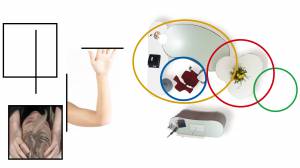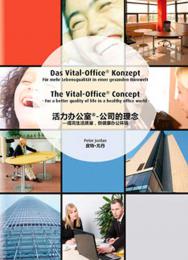I have made it my job to develop integral creative solutions for the office environment, to offer companies more efficiency and people a better quality of life. Therefore I founded the brand, Vital-Office®.
- I am convinced:
- That companies with committed and creative employees are better.
- That committed and creative employees enjoy work.
What is this like in departments such as Sales, Development, Buying. Nowadays, is it not true that a faster ability to adjust to changing factors is an important factor for success? Is not everything done to motivate the employees? Motivate with what aim? To work faster? Or to have more innovation, team spirit and communication in their department? In the end only more creativity and the accompanying efficiency are required.
- Your job can be a part of life with high quality for you.
Creativity comprises “creating” .. producing and organizing. There is no real difference between the inner forms of one’s self, a creative communication or the design of objects. Outside is expression – Inside is origin.
- Creativity is NOT virtuosity
- Creativity is NOT skillfulness
- Creativity is NOT the learned patterns of behavior
- Creativity is NOT envious
- Creativity is NOT offending
- Creativity is NOT dismissive
- Creativity is NOT thinking but being
But:
- Creativity is your authentic way of expressing yourself
- Creativity is pleasure in life
- Creativity is living in the now
- Creativity is authenticity
- Creativity is life
- Creativity is communicative
- Creativity is happy
- Creativity is sympathetic
- Creativity is wealth of ideas, creative power, imagination, wealth of ideas, power to create.
- Creativity feeds on abundance and requires space for inspiration and perception.
Where do you have your best ideas? Where do you feel free, breathe deeply and where are you happy?
The answer is: In nature.
Obviously, most people have had this experience. Not in buildings but outside in nature, not at their desks but when jogging in the park, not at home in bed but on the sunbed in the garden or on the beach. Something happens there in interaction with nature which is different from in an artificial environment.
If we think about our archetypical experiences, this becomes more understandable. Our ancestors lived and developed in nature for many thousands of years. First of all, certainly the fight for survival was on the agenda. For example, a monotonous desert with steep sharp-edged rocks was not especially attractive. Monotony and a sharp-edged quality are therefore always regarded as dangerous and hostile to life.
In contrast, a lush green landscape with a lot of water and many plants and animals seems like a paradise. The grain grows faster and there is also enough game. You had enough to eat and could devote yourself to craft and many other occupations in a creative way in your spare time.
At the same time, the diversity of the paradisiacal nature is the source of inspiration for creative developments.
The consequence in our contemporary partly unconscious perception is: harmonic organic forms symbolise abundance, security and creative freedom. The unfolding of creativity in imagination and the power of expression is facilitated as a result.
Even Rudolf Steiner came to the conclusion: “Through the round or rather, the organic forms, the visitor is more intensively connected to the nature which surrounds him … However, you communicate with deeper levels of nature through the organic forms: ..”
On the other hand, too many straight lines in buildings and furnishings have a predetermined, controlling effect and obstruct individual attempts at creativity. In addition, the reduced, straight use of forms in comparison with the natural luxuriance and abundance is simply banal to our minds.
Consider that we are used to dealing with the abundance and diversity of nature. It is not important to us that each leaf on the tree has a different unique shape and different color. Even our body is a example of diverse forms. If we simply look at our hands. What a use of forms! Or even our faces? Endless types of expression which do not ask too much of us. On the contrary, our brain only becomes a little warm from this challenge. Just like with my horse. It is only really warm after a few kilometers and becomes even faster than before, if it is allowed to run.
Scientists confirm that we only use a small fraction of our brain’s capacity. It is therefore time to start to develop our creative potential and design our offices to be more lively, diverse, colorful, rounder and more flexible.
In contrast, what does a monotonous office environment defined by rectangular shapes achieve? The rectangular is such a simple form: 4 corners and 4 edges. What mental skills are required to count to 4? And what mental skills do you need for the definition of an arc or of a circle, the irrational number PI, an ellipse or a Cassini curve? The differences are immense and yet, we humans have the ability for this.
In this sense it is an insult to our true mental skills. The 4-cornered banality has a degenerative effect. Just like our muscles deteriorate if we do not use them, our brain degenerates and also our ability to be creative.
At the same time, mental skills are a unique gift from God to man. It is the divine impetus (breath of God) which distinguishes us from animals. In this sense, the artist, Friedensreich Hundertwasser, has already described the straight line as virtually “blasphemy”. The straight line is simply too banal in comparison with a round shape. This is the reason it leaves the gift of God unused. (Compare also the parable of the son who buries his share of the inheritance / Bible ….)
Hundertwasser dealt with the subject of creativity in another context. In post-war Vienna housing was scarce and the house rules were very restrictive and obstructed every creative initiative of the tenants. Based on this context, Hundertwasser demanded that each person should have the right to plant a tree. This is why we find trees on the balconies and roofs of the houses in some of his paintings. In addition, he demanded that each person be allowed to build throughout his life. He demanded that each person should be allowed to extend and alter his surroundings, that is, his home. This was to preserve mental skills by means of creative activity. In this sense, Friedensreich Hundertwasser described the straight line as ungodly because it does not occur in nature. He demanded in his “Verschimmelungsmanifest” that the straight line should be prohibited. An extract from this manifesto:
- “Man must again make use of his critical and creative function which he has lost and without which he ceases to exist as a man!
- The use of the rule in architecture is criminal, as is easy to prove; the rule must be seen as the instrument for the decline of the architectonic Trinity.
- You should be prohibited from carrying a straight line on you, at least, morally.”
(Source: http://www1.kunsthauswien.com/deutsch/philosophie.htm )
“Draw a line” is what you say when you want something finished. It is about division. The straight line divides into 2 parts. Left and right or above and below.
A rectangle is generally associated with restriction. Restriction in all four directions of the compass. By means of this restriction, a fault can be produced outside, which, in turn, serves to exercise control. This is the basic requirement for power and control over others.
On the other hand, the rectangular shape is used for the creation of structure in architecture. Town development, building and room construction. We feel safer in a rectangular room than in a round one. We can make conscious use of the strong restriction function of the rectangular shape. Both in a good and in a bad way.
Round shapes do not have edges which you can hold on to. Or do they? None or endless numbers of edges?
Who remembers how we drew the first parabola in school? The calculated points were joined with a line. The more points you calculated, the rounder the curve became. You can say that a round form simply has many points or edges. If you think logically about it, this is an endless number of edges. So many corners also suggest many more possibilities. Possibilities to behave in a flexible way. If one edge does not work, I will take the next one, etc. Theoretically, the more possibilities there are, then logically, the more difficult it is to exercise control.
Round forms stand for more possibilities in terms of development and flexibility as well as more freedom – the basic requirement for creativity. We can therefore use round forms in a conscious way to increase wellbeing, creativity and efficiency in the office.
An efficient, vitalizing, creativity-promoting office environment can be created within a structure by means of, for example, round desks combined with structure-giving rectangular forms, which are usually present in the building and room. On the other hand, there are still an endless number of possibilities of intelligent variation, with round forms producing structures by means of arrangement within a pattern, and many more.
When we work with round shapes, we are dealing with an endless number of possibilities. From the design of the individual desk and additional components, through to the arrangement of the components using any angle and grouping based on geometric patterns. No limits are set on the complexity. Frequently, this kind of intelligent structure in the office furnishings is not perceived consciously, immediately. You recognize the pattern and the geometry on which it is based unconsciously with your mental skills. You simply feel good and possibly somewhat inspired. After all, one part of your brain which otherwise perhaps remains unused, is being activated.
Conclusions:
- Creativity needs stimulation and inspiration.
- The stimulating source is the diversity of nature.
- The biological abundance is the benchmark for stimulating design.
- Linear shapes symbolize regulations, directions, limitations, shortage and the resulting power and authority.
- Round shapes symbolize diversity, abundance, infinite possibilities and freedom.
Downloads:
A meticulous and holistic design of the working environment, however, can promote creativeness and significantly contribute to the wellbeing of body and mind. This design also promotes
...










 /a>
/a>
 /a>
/a>
 /a>
/a>
 /a>
/a>
 /a>
/a>
 /a>
/a>
 /a>
/a>
 /a>
/a>
 /a>
/a>
 /a>
/a>
 /a>
/a>
 /a>
/a>
 /a>
/a>
 /a>
/a>
 /a>
/a>
 /a>
/a>
 /a>
/a>
 /a>
/a>
 /a>
/a>
 /a>
/a>
 /a>
/a>
 /a>
/a>
 /a>
/a>
 /a>
/a>
 /a>
/a>
 /a>
/a>
 /a>
/a>
 /a>
/a>
 /a>
/a>
 /a>
/a>
 /a>
/a>
 /a>
/a>
 /a>
/a>
 /a>
/a>
 /a>
/a>






